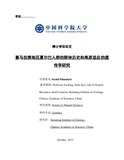Please use this identifier to cite or link to this item:
http://archive.nnl.gov.np:8080/handle/123456789/238| Title: | Genetic analysis of population history and high-altitude adaptation of Sherpas living in the Himalayan region |
| Authors: | Bhandari, Sushil |
| Keywords: | Sherpa Y chromosome mtDNA EPAS1 EGLN1 TED Genetic diversity Human migration High altitude adaptation Himalayas |
| Issue Date: | 5-Dec-2017 |
| Abstract: | Sherpas living around the Himalayas are renowned as high-altitude mountain climbers but when and where Sherpa people originated and how they are capable of staying at less oxygen environment of high altitude remains contentious. In this study, we collected DNA samples from 582 Sherpas living in Nepal and Tibet Autonomous Region of China. Firstly, we analyzed the genetic diversity of both maternal (mitochondrial DNA) and paternal (Y chromosome) lineages in Sherpa and found they share most of their paternal and maternal lineages with indigenous Tibetans. There exist two Sherpa-specific mtDNA sub-haplogroups (C4a3b1 and A15c1) as a result of population expansion after ancestors of Sherpa migrated from Tibetan plateau to Nepal crossing the Himalayas around 1,500 years ago. In addition, our finding rejects the previous theory that Sherpa and Han Chinese served as dual ancestral populations of Tibetans, and conversely suggest that Tibetans are the ancestral populations of the Sherpas. Secondly, after knowing Sherpa as a recently derived population from Tibetans, we genotyped the key genes (EPAS1, EGLN1 and TED) in Sherpa that were reported previously in Tibetans for high altitude adaptation, including the Tibetan enriched deletion (TED) region and 30 single nucleotide polymorphisms (SNPs)(28 EPAS1 SNPs and two EGLN1 missense mutations) in Sherpas. These 30 SNPs and deletion polymorphism were selected based on previous studies of Tibetans which showed deep allelic divergence (FST>0.45) between Tibetans and Han Chinese. We found similar derived allele frequencies (>51%) among Sherpa and Tibetans, but much less derived allele frequencies (<10%) in other world populations. Similarly, there is a distinct haplotype pattern shared among Sherpa and Tibetans for EPAS1 and EGLN1, and these haplotypes are different from those of other populations. In addition, genotyping results of TED in 582 Sherpa samples showed 94%TED in Sherpa samples, including 73% homozygous deletion (Zero copy) and 21% heterozygous Genetic analysis of population history and high-altitude adaptation of Sherpas living in the Himalayan region deletion (one copy) in Sherpa. In contrast, the non-deletion carriers (two copy samples) were seen at high frequency (around 97% of total 2,792 worldwide samples) in other lowlander populations which are rare in Tibetans(<10%) and Sherpa (<6%). Lastly, we conducted association studies between phenotypic (hemoglobin level and degree of blood oxygen saturation level) and genotyping data of EPAS1, EGLN1 and TED in Sherpa. Interestingly, we found several EPAS1 SNPs (rs113305133G, rs116611511G and rs12467821C) and TED having significant association (p value<0.03) with hemoglobin in Sherpa. We observed that Sherpa having derived allele of EPAS1 and EGLN1 SNPs had lower hemoglobin concentration than others carrying the ancestral allele. Likewise, Sherpa containing TED showed lower hemoglobin concentration in comparison with other non-deletion carriers. In summary, our studies suggest that EPAS1, EGLN1 and TED likely underwent positive selection for human adaptation in the Tibetan plateau. In case of Sherpa, who were recently derived from Tibetans, inherited these adaptive traits from their Tibetan ancestors who have been living in Tibet since about 30,000 years ago. Hence, the two population-specific mtDNA haplotypes (C4a3b1 and A15c1) in Sherpa may not have any pronounced effect for high altitude adaptation. Instead, Sherpa and Tibetans share similar genetic and phenotypic traits for high altitude adaptation. |
| Description: | A dissertation submitted to Graduate University of Chinese Academy of Sciences in partial fulfillment of the requirement for the degree of Doctor of Natural Science, Kunming Institute of Zoology, Chinese Academy of Sciences, Kunming, Yunnan, China, 2015. |
| URI: | http://103.69.125.248:8080/xmlui/handle/123456789/238 |
| Appears in Collections: | 500 Natural sciences and mathematics |
Files in This Item:
| File | Description | Size | Format | |
|---|---|---|---|---|
| Thesis Sushil final 20151106.pdf | 2.59 MB | Adobe PDF |  View/Open |
Items in DSpace are protected by copyright, with all rights reserved, unless otherwise indicated.